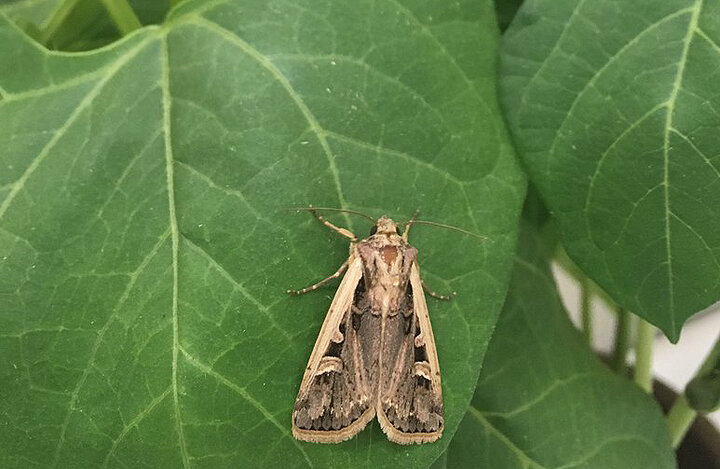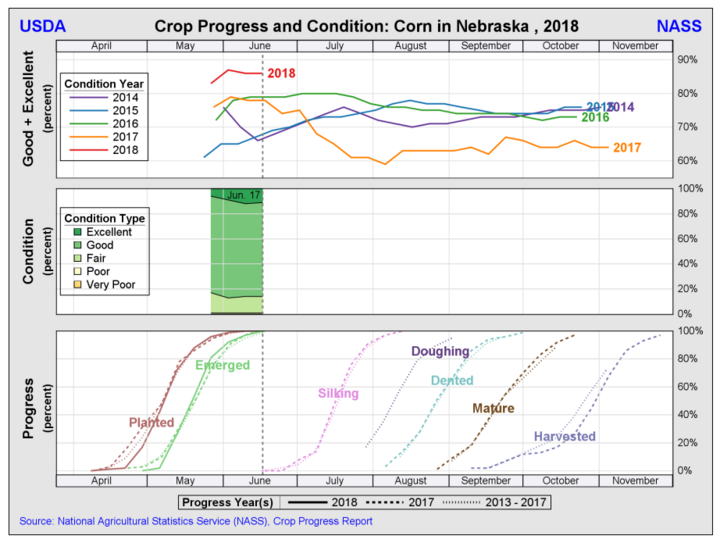Introduction to Insect Degree-Day Models
One of the challenges to controlling insect pests in field crops is knowing when the damaging stage of the insect will be present in the field. Scouting for and effectively treating insects, if numbers are above the economic threshold, can be a challenge because the optimum time will vary from year to year. This is because insect development is dependent on variable weather conditions such as air and soil temperature. Important stages in insect life cycles, such as egg hatch, pupation, adult flight and reproduction can therefore be predicted based on environmental temperatures. By using a degree-day model, you can account for the effect of temperature on insect development and approximate when certain insect development events will occur by measuring degree-days.
Degree-days are units that measure how much heat an insect has been exposed to within upper and lower temperature thresholds. These temperature thresholds establish the range of temperatures that allow for insect growth and development. By studying insect development in the laboratory and in the field, entomologists can determine these thresholds, as well as the number of degree-days that must be accumulated in order for a specific insect species to reach a certain stage in their development. These numbers will vary depending on the insect species.
One common way to measure degree-days is by taking the average temperature of each day and subtracting the lower threshold from that average:
[(Actual Minimum Temp + Actual Maximum Temp)/2] – Lower Threshold
For example, if a given day had a minimum temperature of 50ºF and a maximum temperature of 85ºF, considering a 38ºF Lower Threshold and 75ºF Upper Threshold, degree-days would be calculated as:
[(50 + 85)/2] – 38
[135/2] – 38 = 29.5 degree-days
Note:
- If the average temperature [(Minimum Temperature + Maximum Temperature)/2] is lower than the Lower Threshold (38ºF), change the average temperature to the Lower Threshold before subtracting the Lower Threshold.
- If the average temperature [(Minimum Temperature + Maximum Temperature)/2] is higher than the Upper Threshold (75ºF), change the average temperature to the Upper Threshold before subtracting the Lower Threshold.
A degree-day model will determine on which calendar date to start counting degree-days. After this date, degree-days from each day are accumulated to give the total cumulative degree-days.
Using Degree-Days to Predict Scouting
UNL Entomologists Tom Hunt and Robert Wright, along with University of Minnesota researchers Roger Moon and Bill Hutchison and PhD student Anthony Hanson, in 2014 published a new model for the flight of western bean cutworm (WBC; Figure 1) that has improved predictions of cumulative moth flights and efficiency of field scouting. This model shows that the best method for predicting timing of WBC flight used simple degree-day calculations (see example) beginning March 1, with a 38°F lower threshold and a 75°F upper threshold. The new cumulative flight model indicated that 25% of moth flight should be completed when 2,577 degree-days (Fahrenheit) have accumulated. Field scouting to estimate egg density is recommended at this time.


Figure 1. (top) Western bean cutworm egg mass (left) and larva.
Figure 2. Western bean cutworm
Predicted Dates for 2018 Western Bean Cutworm Flights in Nebraska
Based on the new degree-day model and 2018 temperatures, Table 1 shows the predicted flight patterns for WBC in Nebraska. Keep in mind that scouting is recommended at 25% of the moth flight (dates shown in red). Actual temperatures at each location were obtained from the National Oceanic and Atmospheric Administration (NOAA) and from the High Plains Regional Climate Center for dates from March 1 to June 18, 2018. For dates after June 18, the five-year (2012-2017) average temperatures were used. Due to the use of predicted rather than actual temperatures for these dates, we can expect a potential five-day window of error, with higher-than-average temperatures speeding up and lower-than-average temperatures slowing down insect development.
| Location | 5% | 10% | 25% | 50% | 75% | 90% | 95% |
|---|---|---|---|---|---|---|---|
| Benkelman | 29-Jun | 2-Jul | 4-Jul | 8-Jul | 12-Jul | 15-Jul | 19-Jul |
| Big Springs | 10-Jul | 12-Jul | 19-Jul | 19-Jul | 23-Jul | 26-Jul | 29-Jul |
| Clay Center | 4-Jul | 6-Jul | 9-Jul | 12-Jul | 16-Jul | 20-Jul | 23-Jul |
| Concord | 6-Jul | 8-Jul | 11-Jul | 15-Jul | 18-Jul | 23-Jul | 26-Jul |
| Grand Island | 3-Jul | 5-Jul | 8-Jul | 12-Jul | 15-Jul | 19-Jul | 22-Jul |
| Hastings | 5-Jul | 7-Jul | 10-Jul | 14-Jul | 17-Jul | 21-Jul | 20-Jul |
| Holdrege | 7-Jul | 8-Jul | 11-Jul | 15-Jul | 18-Jul | 22-Jul | 25-Jul |
| Imperial | 11-Jul | 13-Jul | 16-Jul | 20-Jul | 23-Jul | 27-Jul | 30-Jul |
| Kearney | 8-Jul | 10-Jul | 13-Jul | 16-Jul | 20-Jul | 24-Jul | 27-Jul |
| Madrid | 8-Jul | 10-Jul | 14-Jul | 17-Jul | 21-Jul | 25-Jul | 23-Jul |
| North Platte | 12-Jul | 15-Jul | 18-Jul | 21-Jul | 25-Jul | 29-Jul | 1-Aug |
| Ogallala | 9-Jul | 11-Jul | 14-Jul | 18-Jul | 21-Jul | 25-Jul | 24-Jul |
| O'Neill | 13-Jul | 15-Jul | 18-Jul | 22-Jul | 25-Jul | 29-Jul | 1-Aug |
| Scottsbluff | 11-Jul | 13-Jul | 16-Jul | 20-Jul | 23-Jul | 27-Jul | 30-Jul |

WBC Scouting and IPM
Western bean cutworm can be a devastating pest for corn and dry bean fields, particularly in the western half of Nebraska. Please refer to the Nebraska Extension NebGuide, Western Bean Cutworm in Corn and Dry Beans, for more information and keep the following points in mind when considering scouting and treatment:
- Scouting for WBC in corn can be much easier using Nebraska Extension’s Speed Scouting free mobile app or spreadsheet.
- Genetically engineered Bt corn expressing Cry1F (Herculex) proteins can suppress WBC feeding, but will not eliminate all caterpillars. Control of WBC by Cry1F may be less effective in your area than in past years, although VIP3A is still highly effective. (See Nebraska Perspective on Efficacy of Cry1F Bt Corn Against Western Bean Cutworm. Also see the updated Handy Bt Trait Table for those trait packages that protect against WBC.)
- For corn that does not have Bt traits that protect against WBC, the treatment threshold is 5-8% of corn plants with eggs or larvae.
- For scouting western bean cutworm in dry bean, pheromone traps are the easiest method. Note the NebGuide linked above for methods and thresholds for western bean cutworm in dry bean. It is important to set pheromone traps in late June or early July before moths take flight in order to achieve accurate counts.
Degree-day models can help predict when scouting should occur and should also be used in combination with other monitoring methods. UNL black light trap reports from North Platte, Clay Center, Concord, and our new site at the Eastern Nebraska Research and Extension Center (near Mead), are additional resources for monitoring western bean cutworm and other crop pests.
